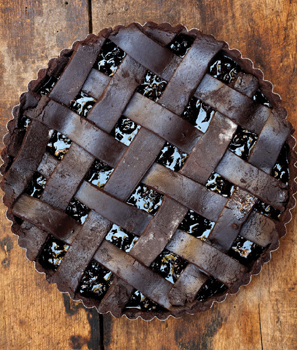Austria is my paternal grandmother’s homeland and a place I still hope to visit. I didn’t get as many Austrian foods as I would have liked when I was a child, though I didn’t realize what I was missing until I was much older. My mother described her mother-in-law as not being very helpful with recipes (or anything), and she had passed away long before I was around to pester her for information. I wonder whether mom’s breaded veal cutlets come from grandma—I’m sure the ketchup she served them with didn’t.
Mozart, Strauss, Schubert, and Haydn hailed from Austria, too, strong evidence that it is a country capable of great refinement and beauty. And I have found that people who love music tend to love food, as well. The national cuisine has incorporated many of the culinary traditions of its former partners in the Austro-Hungarian Empire, along with Germany and Italy, and the court cuisine of the empire was heavily influenced by the French table. My dad only talked about his mother’s peasant foods, about her dumplings, noodles, and polenta (which he called mush), all of which I like. But Vienna, I know, offers much more, and I have promised myself that I will dine there one day.

I have been making this delicious cheese spread for a long time. It is nice to put out when guests arrive and it is good picnic fare, too. I like to serve it with rye crackers, dense rye bread, or a baguette (which is so nontraditional!). Here, I garnish the cheese with chives, but capers, minced cornichons, fish roe (caviar), or anchovies are also tasty options. And any leftover cheese is great in omelets, on scrambled eggs, or in chicken or turkey sandwiches.
Using the best-quality cottage cheese available makes this spread light-years better. I purchase mine from Cowgirl Creamery in Petaluma, which is near where I live. If possible, seek out a creamy, rich, locally made product. If you want a little heat, you can add hot paprika, but be careful not to overwhelm the subtle cottage cheese flavor. | MAKES 2½ CUPS
8 OUNCES SMALL-CURD COTTAGE CHEESE
½ CUP UNSALTED BUTTER, AT ROOM TEMPERATURE
½ SMALL RED ONION, MINCED (ABOUT 3 TABLESPOONS)
1 TO 2 TEASPOONS SWEET PAPRIKA
½ TEASPOON CARAWAY SEEDS, CRUSHED
¼ TO ½ TEASPOON SEA SALT
CHOPPED FRESH CHIVES, FOR GARNISH
In a food processor, combine the cottage cheese, butter, onion, 1 teaspoon of the paprika, and the caraway and process until smooth. Taste and season with the salt and with more paprika, if you like. Transfer to a bowl, garnish with the chives, and serve. Or, cover and refrigerate for up to 2 days before serving. Bring to room temperature before serving.

My paternal grandmother, Stephanie Pawlsyn (she and my grandfather spelled the family name differently), was gone long before I was born. But I have always been interested in Austrian and Polish foods, which I attribute to that genetic connection. Although I grew up eating Campbell’s chicken noodle soup, this recipe yields what I have long envisioned as true chicken noodle soup. In my grandmother’s day, it would have been made with a stewing hen and cooked until the chicken was falling apart.
In this soup, big chunks of vegetables and chicken meat and hearty noodles float in a flavorful stock. I use an antique Austrian wedding band that my husband found for me as guide for cutting the noodles, which gives them a wonderful authentic quality. If you want the finished soup to have a clear broth, cook the noodles separately in boiling water, divide them among the bowls, and ladle the soup over them.
Homemade noodles make this soup special, but if you are pressed for time, you can use store-bought egg vermicelli. Another critical ingredient is the double-strength broth that comes from poaching the chicken in chicken stock. I find it necessary to do this even with the best-quality chickens to ensure enough flavor in the finished soup.
If you prefer to serve the soup as a main course, rather than a first course, leave the meat in big pieces rather than bite-size chunks. I can imagine my grandmother serving this soup with rye bread spread with fresh butter. | SERVES 6 TO 8
1 WELL-RAISED LARGE ROASTING CHICKEN, QUARTERED
3 OR 4 FLAT-LEAF PARSLEY SPRIGS
2 OR 3 CELERY STALKS WITH LEAVES, EACH CUT INTO 3 OR 4 PIECES
1 YELLOW ONION, HALVED AND EACH HALF STUCK WITH 1 WHOLE CLOVE
2 CARROTS, PEELED AND EACH CUT INTO 3 OR 4 PIECES
1 TEASPOON SEA SALT
1½ TEASPOONS BLACK PEPPERCORNS
2 CUPS (8 OUNCES) BREAD FLOUR OR OTHER HIGH-GLUTEN FLOUR
½ TEASPOON SEA SALT
2 EGGS
1½ TEASPOONS WATER
2 CELERY STALKS, SLICED
2 CARROTS, PEELED AND SLICED
2 LEEKS, WHITE AND LIGHT GREEN PARTS ONLY, THINLY SLICED
2 TO 3 TEASPOONS SEA SALT
FRESHLY GROUND BLACK PEPPER
2 TO 3 TABLESPOONS MINCED FRESH FLAT-LEAF PARSLEY, LEAVES,
RINSED AND SQUEEZED DRY, OR 1 TABLESPOON MINCED FRESH TARRAGON, FOR GARNISH
To make the broth, combine all of the ingredients in a large pot and bring to a boil over medium-high heat. Decrease the heat to a gentle simmer and cook, skimming off any foam that rises to the surface, for 30 minutes. Turn off the heat and let sit undisturbed for 1 hour, then remove the chicken from the pot.
When the chicken is cool enough to handle, remove the meat from the bones and peel away the skin. Break up the meat into chunky spoon-size pieces and set aside. If the broth is not as strongly flavored as you would like, return the skin and bones to the pot and bring the broth back to a boil. Decrease the heat to a steady simmer and cook, skimming as needed, until reduced by one-fourth to one-third. Then strain the broth through a fine-mesh sieve and reserve. (The broth may be made up to 1 day ahead; cover and refrigerate the chicken and the broth separately.)
To make the noodles, in a large bowl, stir together the flour and salt. In a small bowl, whisk together the eggs and water until blended. Create a well in the center of the flour mixture and pour in the eggs. With a fork, gradually combine the wet ingredients with the dry ingredients until a rough dough forms. Turn the dough out onto a floured work surface and knead for about 5 minutes, until smooth. Shape into a ball, cover with an overturned bowl, and let rest for 20 minutes.
Lay a few kitchen towels flat on a work surface that you can dedicate to pasta drying and dust the towels lightly with flour. Anchor a standard manual pasta machine to your work surface and set the rollers at the widest setting. Cut the dough into 5 equal pieces and slip 4 pieces back under the bowl. Hand flatten the fifth piece to about ½ inch thick and run it through the rollers of the pasta machine. Fold the dough into thirds, like a business letter, dust it with a little flour to prevent sticking, and run it through the rollers again. Repeat until the dough is smooth and somewhat silky. Reset the rollers to the next narrowest setting and pass the dough through the rollers and then pass it through the same setting again. Continue passing the dough through progressively narrower settings, lightly dusting the dough or rollers with flour as needed to prevent sticking, until the dough sheet is about ¼ inch thick. Lay the sheet on a flour-dusted work surface and repeat with the remaining dough pieces.
You can cut the dough sheets into thin ribbons by hand or by machine. To cut by hand, dust a dough sheet lightly with flour and fold it over itself to form a manageable rectangle. Using a very sharp knife, cut the rectangle crosswise into ⅛-inch-wide strips, then shake the strips free. If using a pasta machine, secure the strand-cutting attachment to the machine (make sure it will cut the noodles about ⅛ inch wide), lightly dust a dough sheet, and pass it through the cutters. As soon as the noodles are cut,
lay them on the flour-dusted towels, dust them with a little flour, and lightly run your fingers through them to make sure all of the surfaces get coated. Don’t worry about getting too much flour on the noodles. You can shake off any excess when you are ready to cook them. Repeat until you have cut all of the dough sheets into noodles.
When the noodles are dry to the touch, gather them up onto a rimmed baking sheet and cover them with a kitchen towel to keep the dust off. Leave them out on the counter until needed (do not put them in the refrigerator). They will keep for up to 1 day.
To make the soup, if you like, skim off the fat from the top of the broth and discard. In a large pot, combine the celery, carrots, and reserved broth and bring to a boil over high heat. Decrease the heat to a simmer and cook for 10 to 15 minutes, until the vegetables are tender. Add the reserved chicken, the noodles (shake off the excess flour), and the leeks and cook, maintaining a steady simmer, until the soup is bubbly hot and the noodles are cooked through. This should take about 5 minutes. (If the chicken is straight from the refrigerator, add it to the pot a minute or two ahead of the noodles so you don’t overcook the noodles.) Season the soup to taste with the salt and with the pepper. (It will probably need more salt than you think it will.)
Ladle the soup into warmed bowls and garnish with the parsley. Serve at once.

MAKES 4 TO 6 QUARTS
3 TO 5 POUNDS CHICKEN BACKS, NECKS, AND/OR WINGS, PLUS SOME FEET, IF POSSIBLE
2 CARROTS, CHOPPED
2 OR 3 CELERY STALKS, CHOPPED
½ HEAD GARLIC, CLOVES SEPARATED AND LIGHTLY
SMASHED, WITH LOOSE SKINS REMOVED
1 LARGE YELLOW ONION, COARSELY CHOPPED, WITH 1 WHOLE CLOVE STUCK INTO 2 OF THE PIECES
3 BAY LEAVES
STEMS FROM ¼ BUNCH FLAT-LEAF PARSLEY
3 OR 4 THYME SPRIGS
1 TABLESPOON BLACK PEPPERCORNS
Remove as much visible fat from the chicken pieces as possible. In a stockpot, combine the chicken with cold water to cover (preferably filtered water) and bring to a rolling boil over high heat. Add the carrots, celery, garlic, onion, bay, parsley, thyme, and peppercorns and decrease the heat to a simmer. Cook at a steady simmer, uncovered, for 3 hours. Check frequently and skim off any foam that rises to the surface (one of the secrets of a good stock is to skim often).
Remove from the heat and strain through a fine-mesh sieve. For a more concentrated flavor, return the strained stock to the pot and simmer until reduced by one-fourth to one-third. Let cool, cover, and refrigerate for up to 1 week or freeze for up to 2 months. Lift off and discard the fat from the surface before using.

Rabbit With Sour Cream
WITH STEAMED POTATOES AND BACON RED CABBAGE
The casserole part of this recipe is best cooked in a big cast-iron or enameled cast-iron Dutch oven. If you have neither, choose any big, heavy pot with a tight-fitting lid that will hold all of the ingredients.
Your butcher will probably be happy to break down the rabbit for you, but if you want to give it a try yourself, I have included
some tips. The marinade works equally well with chicken or with game birds such as pheasant or quail. The spiced cabbage may be made a day or two ahead, so you can make it on the same day you put the rabbit in the marinade. The cabbage is also good with sausage and pork chops. Double-smoked bacon, which is a specialty of Polish and German smokehouses, is bacon that is left in the smoker much longer than regular American bacon, usually at least four times the normal amount of time. Nowadays, some American companies are producing it. If you cannot locate it, regular bacon may be substituted.
If your steamer is big enough, I recommend cooking extra potatoes and serving them the next day using this simple preparation: Melt about 4 tablespoons unsalted butter with some first-rate extra virgin olive oil in a sauté pan over medium-high heat, add the potatoes, and toss them until they are nice and hot and lightly browned. Transfer them to a bowl, roll them around in some chopped fresh chives or tarragon, and pour any butter and oil remaining in the pan over the top. This preparation is too much with the rich rabbit dish, but it is perfect with simple grilled fish. Among my favorite potato varieties for this dish are Caribe, Cranberry Red, Red Sangre, French Fingerling, Desiree, and Russian Banana. | SERVES 6 TO 8
2 CUPS RED WINE VINEGAR
2 CUPS DRY RED WINE
2 CUPS WATER
4 TEASPOONS BLACK PEPPERCORNS, SMASHED
2 TEASPOONS JUNIPER BERRIES, SMASHED
4 BAY LEAVES
To make the marinade, combine all of the ingredients in a saucepan, bring to a boil over high heat, and boil for 5 minutes. Remove from the heat and let cool completely.
Lay the rabbit pieces in a single layer in a glass or ceramic baking dish. Pour the cooled marinade over the rabbit and turn the pieces as needed to coat on all sides. Cover and refrigerate for 48 hours, turning the pieces occasionally.
3 OUNCES DRIED PORCINI OR SHIITAKE MUSHROOMS,
SOAKED IN HOT WATER TO COVER FOR 15 TO 20 MINUTES, DRAINED, AND SOAKING WATER RESERVED
JUICE OF 2 LEMONS
6 FRESH THYME SPRIGS
STEMS FROM ⅓ BUNCH FRESH MARJORAM OR FLAT-LEAF PARSLEY SPRIGS
OLIVE OIL, FOR BROWNING
6 SLICES DOUBLE-SMOKED BACON OR OTHER SMOKY BACON, CUT CROSSWISE INTO NARROW STRIPS
2 YELLOW ONIONS, SLICED
4 CARROTS, PEELED AND SLICED
3 SLICES DOUBLE-SMOKED BACON OR OTHER SMOKY BACON, CUT CROSSWISE INTO NARROW STRIPS
1 LARGE RED ONION, SLICED
2 CLOVES GARLIC, MINCED
1 LARGE HEAD RED CABBAGE, CORED AND THINLY SLICED OR SHREDDED
1 TABLESPOON CARAWAY SEEDS
2 LARGE APPLES OR PEARS, PEELED, CORED, AND CHOPPED
GRATED ZEST AND JUICE OF 1 LEMON
2 CUPS DRY RED WINE
3 TO 4 TABLESPOONS RED WINE VINEGAR
3 TO 4 TABLESPOONS HONEY
SEA SALT AND FRESHLY GROUND BLACK PEPPER
12 SMALL FRENCH FINGERLING OR OTHER WAXY POTATOES
SEA SALT
MINCED FRESH FLAT-LEAF PARSLEY OR FRESH TARRAGON OR CHOPPED CHIVES, FOR GARNISH
1 CUP SOUR CREAM OR CRÈME FRAÎCHE, OR A MIXTURE
Remove the rabbit from the marinade and strain the marinade into a clean container. Pour the mushroom soaking water through a fine-mesh sieve (to catch any grit) into the marinade and then add the lemon juice. Set aside. Gather the thyme and marjoram together, tie together with kitchen twine, and set aside.
Have ready one or more big plates or platters for holding the meats and vegetables as are they are browned. Coat the bottom of a Dutch oven lightly with olive oil and heat over medium-high heat. Working in batches, add the bacon, rabbit, onion, and carrots to the pot and brown well on all sides, transferring each batch to the plate as it is finished. Add more oil between batches if necessary.
If the shiitakes are whole, quarter them or for smaller mushrooms cut in half; the pieces should be sized to eat easily. Return the browned meats and vegetables to the pot; add the rehydrated mushrooms, the strained marinade mixture, and the herb bundle. Bring to a boil and reduce the heat to a simmer, skimming off any foam that rises to the surface. Cover and cook gently, checking occasionally and skimming off any foam, for 45 minutes, until the vegetables are tender and the rabbit is done. Alternatively, once all of the ingredients are in the pot and are at a boil, cover the pot, transfer it to a preheated 325°F oven, and cook for about 1 hour.
To make the cabbage, in a big sauté pan, fry the bacon in its own fat until crisp. Add the onion and garlic and cook, stirring occasionally, for 5 to 8 minutes, until soft. Add the cabbage and cook, stirring and tossing, for 3 to 5 minutes, until nicely wilted. Add the caraway, apples, lemon juice and zest, wine, vinegar, and honey. Bring to a boil, decrease the heat to a simmer, cover, and cook for 45 minutes to 1 hour. If near the end of cooking it is too juicy for your liking, uncover the pan to allow the liquid to reduce. When the cabbage is ready, it should be tender and glistening and taste nicely sweet and sour. Season with salt and pepper, cover, and set aside off the stove, and then reheat just before serving. (This cabbage may be cooked a day ahead, cooled, covered, and refrigerated and then reheated just before serving.)
About 25 minutes before serving, pour water into a steamer pot, place over medium-high heat, and set the rack in place. Add the potatoes to the rack and liberally sprinkle them with salt. If you need to layer the potatoes, sprinkle each layer with salt. Cover the steamer and as soon as the water is boiling, decrease the heat to a simmer and steam for 15 to 20 minutes, until the potatoes are fork-tender. Remove the steamer from the heat and let the potatoes rest for at least 3 minutes before removing them from the steamer. Transfer the potatoes to a nice bowl or platter, garnish with the parsley, and keep warm.
To finish the rabbit and vegetables, using a slotted spoon, transfer the meat and vegetables to a serving platter and keep warm. Discard the herb bundle. Increase the heat under the pot and bring the juices to a boil. Cook until they are thick enough to coat a spoon nicely. Taste and adjust the seasoning with salt and pepper.
To serve, spoon some of the sauce over the rabbit and vegetables and set the platter on the table. Spoon the sour cream into a small bowl and place the sour cream, potatoes, and cabbage alongside the rabbit and vegetables. Invite your guests to spoon sour cream onto the stew to their taste.

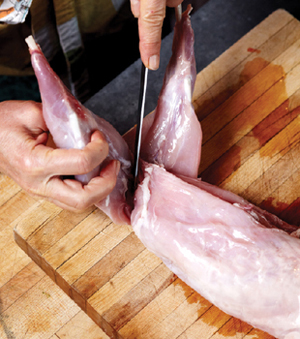
1 USING A BONING KNIFE, CUT EACH HIND LEG OFF AT THE JOINT.

2 LAY EACH LEG ON THE CUTTING BOARD, INNER THIGH FACING UP.
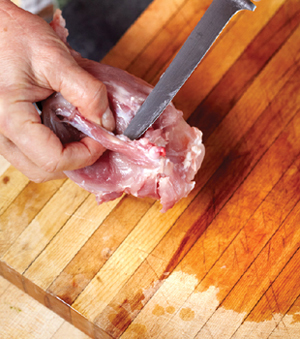
3 STARTING AT THE BALL JOINT, CUT DOWN ALONG THE SEAM OF THE LEG TO EXPOSE THE THIGH BONE.

4 SET EACH BONELESS LEG AND THIGH ASIDE AS YOU WORK ON THE REST.
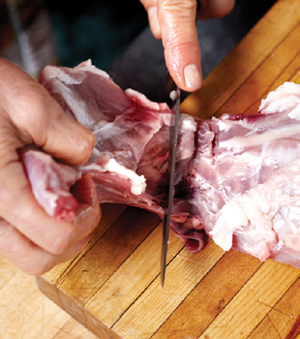
5 CUT EACH OF THE FRONT LEGS OFF AT THE JOINT. THE BEST WAY TO DO THIS IS TO LIFT THE LEG UP AND AWAY FROM THE BODY AND THEN CUT UNDER AND OFF.
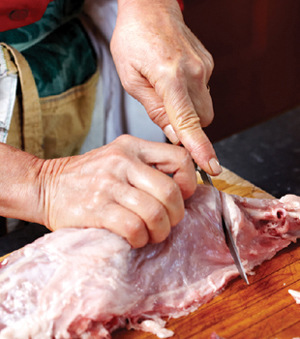
6 CUT THE LOIN SECTION OF THE BODY INTO TWO PIECES, CUTTING WHERE THE RIB CAGE ENDS (FRONT END) SO YOU HAVE TWO BONE-IN PIECES.
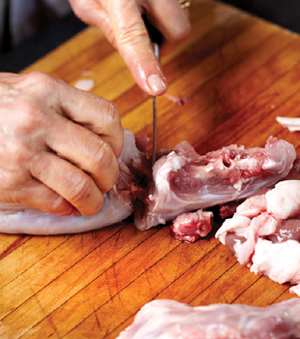
7 TRIM OFF ANY EXCESS BACKBONE FROM THE FRONT PORTION OF THE BODY AND THE HIP SOCKETS FROM THE BACK-LEG PORTION OF THE BODY.
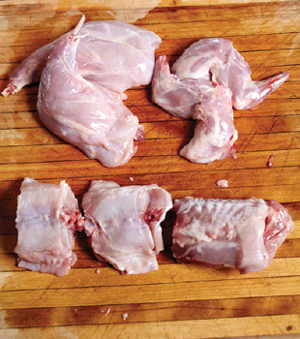
8 ALTERNATIVELY, YOU CAN BONE THE LOINS FROM THE BACKBONE. YOU WOULD THEN COOK THE LOIN LESS TIME, BROWNING IT AND THEN ADDING IT BACK TO THE STEW FOR ONLY 6 TO 8 MINUTES.
Raspberry-Currant Linzer Torte
RASPBERRY-CURRANT LINZER TORTE
I started making this dessert, named for the Austrian city of Linz, in the 1970s. The first time was for my sister Mary’s wedding. It was the groom’s cake and I think I added whole wheat flour for nuttiness. In the early days I used almonds, but I now think that hazelnuts are more “authentic.” My old brown Gourmet cookbook from the 1970s says to use almonds and does not include cocoa. It tastes great either way.
If possible, use homemade jam. Raspberry or currant would be the classic choice. But in early summer, I often make a quick jam from a combination of whatever is ripe in the garden: raspberries, currants, fraises des bois, and strawberries. I have included the instructions for a quick raspberry-currant jam here, but if you decide to buy the jam, you will need 1 to 1½ cups. Whether you use homemade or store-bought jam, just make the torte!
The crust is basically a cookie dough that you press into a tart pan. Grind the nuts in an old-fashioned nut grinder, if you are lucky enough to have one, which makes them flaky and light. Otherwise, chop them by hand, shred them by the handful on a box grater, or pulse them in a food processor. If you use a food processor, be sure to use short pulses and stop the moment the consistency is correct or you will end up with a nut paste. If you want a more refined lattice top, grind the nuts finer. I prefer some coarseness because it improves the taste and texture.
To suggest ice cream is gilding the lily, but a little vanilla ice cream alongside each slice would be nice with this, along with a cup of Viennese-style coffee. | MAKES 1 (8-TO 9-INCH) TORTE; SERVES 6 TO 8
1 CUP ALL-PURPOSE FLOUR
½ CUP WHOLE WHEAT FLOUR
¼ TEASPOON SEA SALT
1½ TABLESPOONS NATURAL UNSWEETENED DUTCH-PROCESS COCOA POWDER
½ TEASPOON GROUND GINGER, OR 2 TEASPOONS PEELED AND GRATED FRESH GINGER
½ TEASPOON GROUND CINNAMON
¼ TEASPOON GROUND CLOVES
1 CUP ALMONDS OR HAZELNUTS, FLAKED, FINELY SHREDDED, OR PULSED IN A FOOD PROCESSOR
1 CUP GRANULATED SUGAR
1 CUP UNSALTED BUTTER
3 EGG YOLKS
GRATED ZEST OF 1 LEMON
1 POUND FRESH RASPBERRIES AND RED CURRANTS, PREFERABLY IN EQUAL PARTS
1½ CUPS GRANULATED SUGAR
GRATED ZEST OF 1 LEMON
2 TABLESPOONS FRESHLY SQUEEZED LEMON JUICE
1 EGG WHITE WHISKED WITH 1 TEASPOON WATER, FOR EGG WASH
CHOPPED HAZELNUTS OR SLICED ALMONDS, FOR GARNISH
CONFECTIONERS’ SUGAR, FOR DUSTING
To make the crust, in a medium bowl, stir together the all-purpose flour, whole wheat flour, salt, cocoa powder, ginger, cinnamon, cloves, and almonds until well mixed. In a large bowl combine the granulated sugar and butter and beat with a handheld mixer on medium-high speed or with a wooden spoon until light and fluffy. Add the egg yolks and lemon zest and stir until incorporated. Add the flour mixture to the butter mixture and stir until thoroughly combined and a soft dough forms.
Divide the dough into 2 portions, one twice as large as the other. Press out each portion like a thick hamburger patty, wrap separately in plastic wrap, and refrigerate for at least 30 minutes, until chilled, or up to 24 hours.
To make the jam, remove any stems from the currants. In a nonreactive pot, combine the currants and raspberries, granulated sugar, and lemon zest and juice and bring to a boil over high heat. Decrease the heat to a simmer and cook, stirring often, for 15 to 20 minutes, until thick and jammy and a candy thermometer registers 228°F. Be sure to cook the jam long enough (being careful not to scorch) for it to thicken. Remove from the heat and let cool. You should have 1 to 1½ cups.
To bake the torte, preheat the oven to 375°F. Remove only the larger dough portion from the refrigerator and press it onto the bottom and sides of an 8- or 9-inch round tart pan with a removable bottom. Pour in the cooled jam and then refrigerate while you make the lattice for the top.
On a lightly floured work surface, roll out the second dough portion to match the diameter of your pan. With a table knife or a pastry or pizza cutter, cut the dough into ½- to ¾-inch-wide strips. For the fanciest lattice top, lay half of the strips parallel to one another across the tart, spacing them about ½ inch apart. Lay the remaining strips perpendicular to the first strips, spacing them about ½ inch apart and gently weaving them over and under the first strips. If a strip breaks, just press the broken edges back together. Alternatively, for a simple lattice, place half of the strips parallel to one another across the tart, spacing them about ½ inch apart. Then lay the remaining strips on top of and perpendicular to the first strips, spacing them about ½ inch apart. Press the ends of each strip onto the edge of the bottom crust.
Brush the lattice strips with the egg wash, then sprinkle the hazelnuts evenly around the outside edge. Bake for 40 to 50 minutes, until the crust is golden brown. (Start checking after 30 minutes and decrease the heat to 350°F if the crust seems to be browning too fast.) Let cool completely on a wire rack, then remove the pan sides. Using a wide metal spatula, carefully slide the torte onto a serving plate. Liberally dust the top of the torte with confectioners’ sugar and cut into wedges to serve.
